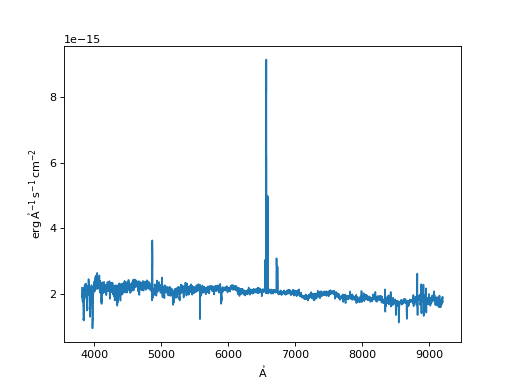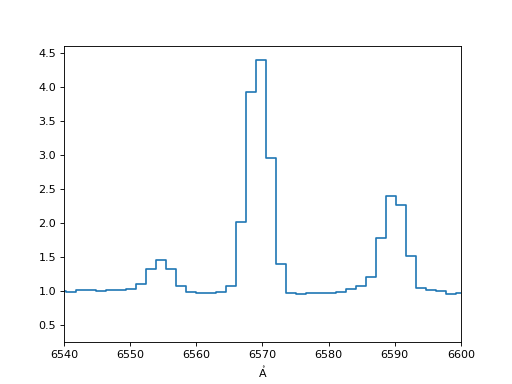Specutils Documentation¶

specutils is a Python package for representing, loading,
manipulating, and analyzing astronomical spectroscopic data. The
generic data containers and accompanying modules provide a toolbox that the
astronomical community can use to build more domain-specific packages. For more
details about the underlying principles, see
APE13, the
guiding document for spectroscopic development in the Astropy Project.
Note
While specutils is available for general use, the API is in an early enough development stage that some interfaces may change if user feedback and experience warrants it.
Getting started with specutils¶
As a basic example, consider an emission line galaxy spectrum from the SDSS. We will use this as a proxy for a spectrum you may have downloaded from some archive, or reduced from your own observations.
We begin with some basic imports:
>>> from astropy.io import fits
>>> from astropy import units as u
>>> import numpy as np
>>> from matplotlib import pyplot as plt
>>> from astropy.visualization import quantity_support
>>> quantity_support() # for getting units on the axes below
Now we load the dataset from its canonical source:
>>> filename = 'https://data.sdss.org/sas/dr16/sdss/spectro/redux/26/spectra/1323/spec-1323-52797-0012.fits'
>>> # The spectrum is in the second HDU of this file.
>>> with fits.open(filename) as f:
... specdata = f[1].data
Then we re-format this dataset into astropy quantities, and create a
Spectrum1D object:
>>> from specutils import Spectrum1D
>>> lamb = 10**specdata['loglam'] * u.AA
>>> flux = specdata['flux'] * 10**-17 * u.Unit('erg cm-2 s-1 AA-1')
>>> spec = Spectrum1D(spectral_axis=lamb, flux=flux)
And we plot it:
>>> f, ax = plt.subplots()
>>> ax.step(spec.spectral_axis, spec.flux)
(Source code, png, hires.png, pdf)

Now maybe you want the equivalent width of a spectral line. That requires normalizing by a continuum estimate:
>>> import warnings
>>> from specutils.fitting import fit_generic_continuum
>>> with warnings.catch_warnings(): # Ignore warnings
... warnings.simplefilter('ignore')
... cont_norm_spec = spec / fit_generic_continuum(spec)(spec.spectral_axis)
>>> f, ax = plt.subplots()
>>> ax.step(cont_norm_spec.wavelength, cont_norm_spec.flux)
>>> ax.set_xlim(654 * u.nm, 660 * u.nm)
But then you can apply a single function over the region of the spectrum containing the line:
>>> from specutils import SpectralRegion
>>> from specutils.analysis import equivalent_width
>>> equivalent_width(cont_norm_spec, regions=SpectralRegion(6562 * u.AA, 6575 * u.AA))
<Quantity -14.7396 Angstrom>
(Source code, png, hires.png, pdf)

While there are other tools and spectral representations detailed more below, this gives a test of the sort of analysis specutils enables.
Using specutils¶
For more details on usage of specutils, see the sections listed below.
- Installation
- Overview of How Specutils Represents Spectra
- Working with Spectrum1Ds
- Working With SpectrumCollections
- Working with Spectral Cubes
- Spectral Regions
- Analysis
- Line/Spectrum Fitting
- Manipulating Spectra
- Spectrum Arithmetic
- Loading and Defining Custom Spectral File Formats
- Identifying Spectrum1D Formats
Get Involved - Developer Docs¶
Please see Contributing for information on bug reporting and contributing to the specutils project.